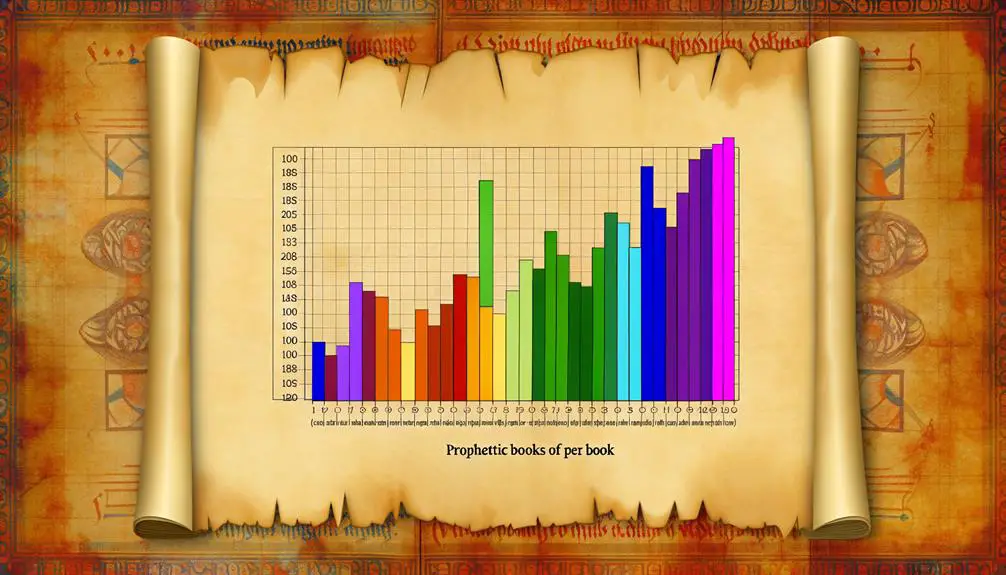Kicking off an intriguing exploration into the Bible's structure, find out how verse counts unlock hidden layers and themes.

Number of Verses in Each Book of the Bible
You might think that counting the verses in each book of the Bible is a trivial pursuit, yet it offers profound insights into the structure and emphasis of biblical texts.
By exploring the numerical landscape of the Pentateuch, the historical and poetic books, the prophetic writings, the Gospels, Acts, the Pauline and General Epistles, and Revelation, you'll uncover patterns and themes that remain obscured without such analysis.
This journey through the scriptures isn't just about numbers; it's an invitation to understand the weight and distribution of divine messages across the biblical canon.
Stick around to discover how these findings illuminate the text's deeper layers.
Key Takeaways
- The Bible features a wide range of verse counts across its books, reflecting diverse themes and literary styles.
- Verse counts vary significantly, from the lengthy narratives in the Pentateuch to the concise messages in some of the Epistles.
- The number of verses in each book contributes to understanding the book's thematic focus and narrative structure.
- Detailed verse counts, such as in the Prophetic Books and Pauline Epistles, highlight the depth and complexity of biblical teachings.
The Pentateuch Verse Count

The Pentateuch, comprising the first five books of the Bible, contains a total of 5,852 verses, each offering a unique insight into the foundations of Judeo-Christian beliefs and laws. Traditionally attributed to Mosaic authorship, these texts serve as the cornerstone for understanding the covenant relationship between God and His chosen people. You'll find that the intricate details of laws, narratives, and genealogies within these books aren't merely historical records but are imbued with theological significance, emphasizing covenant themes at every turn.
Analyzing the verse count, you'll notice that each book contributes a distinct portion to the overarching narrative, from creation and the fall in Genesis to the preparations for entering the Promised Land in Deuteronomy. This numerical detail underscores the meticulous structure of the Pentateuch, reflecting the careful arrangement of theological concepts around covenant themes. The notion of Mosaic authorship further intertwines with these themes, suggesting that through Moses, God provided not just the law but a comprehensive guide for covenantal living.
The covenant themes, articulated through laws and stories across these verses, lay the groundwork for understanding God's expectations of His people and their relationship with Him. This foundational aspect of the Pentateuch highlights the importance of each verse in constructing a detailed narrative of God's covenant and His interactions with humanity. As you delve into the verse count, you're not merely encountering a quantitative aspect of scripture but engaging with the qualitative depth of its covenantal framework.
Historical Books Overview

Moving beyond the foundational Pentateuch, you'll encounter the historical books, which chronicle the unfolding of God's covenant with His people through vivid narratives of faith, failure, and redemption. These books, from Joshua to Esther, offer a deep dive into the historical context that shaped the nation of Israel, its leaders, and its people.
Here are some key aspects to consider:
- Historical Context: Each book is rooted in specific periods of Israel's history, from the conquest of Canaan to the return from Babylonian exile. Understanding the historical backdrop enhances the comprehension of the text, revealing the intricacies of God's guidance and the people's responses to His covenant.
- Authorship Debates: The question of who wrote these books has been a subject of scholarly debate. While traditional attributions exist, such as Joshua being credited to Joshua himself, critical scholarship often suggests composite authorship or later editing stages, particularly in light of the Deuteronomistic history theory.
- Literary Uniqueness: Unlike the Pentateuch's law-oriented narrative, the historical books blend storytelling with theological insights, making them a rich source for understanding the practical outworking of faith in historical events.
- Covenant Theme: The covenant between God and His people is a central theme, with the historical books detailing the blessings of obedience and the consequences of disobedience, thereby reinforcing the covenantal relationship's significance.
In exploring these books, you're not just encountering ancient history but diving into debates on authorship, the interpretation of historical context, and the dynamic narrative of faith's journey across generations.
Poetic Books Verse Numbers

Delving into the poetic books, you'll discover that their verse numbers significantly vary, reflecting the depth and diversity of their content. This variance is not merely quantitative but deeply entwined with the lyrical imagery and symbolic significance that these books carry. The poetic books are a testament to the human experience, exploring emotions, wisdom, and the divine in a manner that is profoundly evocative and richly layered.
Book |
Number of Verses |
Symbolic Significance |
|---|---|---|
Job |
1,070 |
Represents the endurance of faith |
Psalms |
2,461 |
Embodies worship and the human soul's cry |
Proverbs |
915 |
Symbolizes wisdom and moral guidance |
Ecclesiastes |
222 |
Reflects on life's vanity and the search for meaning |
Song of Songs |
117 |
Exemplifies divine love and human passion |
Analyzing these numbers reveals a fascinating insight into the poetic books' structure and intent. Job, with its extensive verse count, delves deeply into the themes of suffering and faith, using lyrical imagery to convey profound truths about human endurance and divine sovereignty. Psalms, the longest book, uses its verses to span the breadth of human emotion from despair to exultation, encapsulating the essence of worship and communication with the divine.
Proverbs and Ecclesiastes, though differing in verse count, both serve as guides to life, offering wisdom through succinct, impactful sayings and reflections on life's ephemeral nature and the pursuit of meaning. Song of Songs, with the fewest verses, concentrates its lyrical imagery on the intensity of love, capturing its symbolic significance in the human and divine context.
Each book's verse count, thus, is a key to understanding its thematic depth and the richness of its contributions to the tapestry of biblical literature.
Prophetic Books Detailed

Exploring the prophetic books unveils a complex tapestry of forewarnings, divine interventions, and calls for repentance that are foundational to understanding biblical prophecy and its implications for both past and contemporary societies. These texts are rich with prophetic symbolism and apocalyptic imagery, challenging readers to decipher their meanings and apply their lessons.
The prophetic books, each with a unique narrative and purpose, contribute significantly to the theological and moral framework of the Bible. Here's a closer look at some of their verse counts and thematic elements:
- Isaiah (1,292 verses): A cornerstone of prophetic literature, Isaiah blends forewarnings with promises of redemption, utilizing prophetic symbolism to depict the consequences of Israel's disobedience and the hope of their eventual restoration.
- Jeremiah (1,364 verses): This book presents a longer narrative, rich in apocalyptic imagery, foretelling the fall of Jerusalem. It also emphasizes the importance of a new covenant, highlighting God's enduring faithfulness.
- Ezekiel (1,273 verses): Ezekiel's visions and symbolic acts serve as powerful metaphors for Israel's condition and God's sovereign plans. Its apocalyptic imagery, especially in the vision of the dry bones, offers profound insights into resurrection and restoration.
- Daniel (357 verses): Though smaller in verse count, Daniel is significant for its apocalyptic literature, predicting future events and the ultimate triumph of God's kingdom. It's a pivotal resource for understanding eschatological themes.
These books, through their detailed narratives and symbolic language, invite readers into a deeper exploration of divine justice, mercy, and the ultimate hope for redemption, encapsulating the essence of prophetic literature.
Gospels and Acts Analysis

You'll find the analysis of the Gospels and Acts reveals significant variations in verse count, reflecting the unique narrative and theological emphases of each book.
By examining Gospel verse counts, you're engaging with the foundational texts of Christian tradition, highlighting the distinct messages and contexts of Matthew, Mark, Luke, and John.
Turning to Acts, insights into its chapters shed light on the early Christian community's development, emphasizing the spread of the Gospel and the role of the Holy Spirit.
Gospel Verse Count
Analyzing the Gospel verse count reveals a fascinating insight into the narrative structure and thematic emphasis of each book, including Acts, within the New Testament. The distribution of verses across the Gospels and Acts underscores the unique focus of each narrative, from the parables' significance to the detailed resurrection accounts.
- Matthew: 1,071 verses – Rich in parables, emphasizing Jesus' teachings.
- Mark: 678 verses – Concise narrative, focusing on Jesus' actions.
- Luke: 1,151 verses – Detailed account of Jesus' life, parables, and acts.
- John: 879 verses – Deep theological insights, highlighting Jesus' identity and resurrection.
This breakdown not only highlights the thematic priorities of each Gospel but also the Acts' role in the early church's history, setting a foundation for understanding the New Testament's message and its application to Christian life.
Acts Chapter Insights
Building on our understanding of the verse count and thematic emphasis in the Gospels, let's now examine the Acts of the Apostles to uncover how its chapters contribute to the narrative and theological development of the New Testament.
Acts serves as a bridge between the Gospels and the Epistles, detailing the early church's explosive growth and the pivotal role of Paul's journey in spreading Christianity beyond Jewish communities. Through its verses, we witness the Holy Spirit's empowerment of believers, the establishment of the church in Jerusalem, and the challenges faced by early Christians.
Each chapter meticulously documents the geographic and cultural landscapes that shaped the early Christian message, providing a foundational context for Paul's missionary journeys and the subsequent expansion of the early church.
Pauline Epistles Verse Count

You'll find that the Pauline Epistles, attributed to Apostle Paul, vary significantly in their verse count, reflecting a range of theological depth and historical context.
An analysis of these counts not only sheds light on Paul's prolific contributions to the New Testament but also highlights the longest epistles, revealing their complex narratives and doctrinal richness.
This examination offers insights into the compositional structure and thematic emphasis across these foundational Christian texts.
Pauline Epistles Overview
The Pauline Epistles, foundational texts of Christian theology, encompass a diverse range of verse counts across their thirteen books. These letters, penned by the Apostle Paul, reflect his missionary journeys and the diverse communities he engaged with. Behind each Epistle lies a unique purpose, often addressing theological issues, ethical guidelines, and the consolidation of early Christian communities.
- Romans: Deep theological exposition
- Corinthians: Addressing community disputes
- Galatians: Justification by faith
- Ephesians: Unity in the body of Christ
Paul's travels significantly influenced the content and tone of his writings. Each letter served as a means to guide, correct, and encourage the fledgling Christian communities scattered across the Roman Empire. This variegated background is crucial for understanding the distinct verse count and thematic focus of each Pauline Epistle.
Verse Count Analysis
Exploring the verse counts of the Pauline Epistles reveals a nuanced landscape of textual composition, reflecting the diverse contexts and purposes behind these foundational texts. Dive deeper, and you'll find that verse distribution across these letters isn't uniform, hinting at the varied themes and theological depth Paul addressed with different communities.
Translation differences further complicate the picture. For instance, some translations may divide sentences into multiple verses or combine them into one, affecting the total verse count. This variation isn't trivial; it shapes how readers engage with the text, potentially emphasizing different aspects of Paul's teachings.
Understanding these dynamics requires a careful examination of the epistles, acknowledging that each verse, regardless of count, contributes to the rich tapestry of Christian doctrine.
Notable Longest Epistles
Among the Pauline Epistles, Romans stands out for its substantial verse count, reflecting its depth in theological discourse and complexity in addressing the early Christian community's issues.
Delving into the notable longest epistles further:
- Romans: Central to understanding Paul's theological framework, often igniting authorship debates.
- 1 Corinthians**: Rich in addressing church conduct, showcasing diverse epistle purposes.
- 2 Corinthians: A personal touch reveals the apostle's struggles and defense of his apostleship.
- Acts**: Although not an epistle, its narrative connects Paul's missions with the broader Christian movement.
Each epistle's length serves a purpose, from doctrinal exposition to addressing specific community challenges. The verse count not only signifies the document's size but also hints at its complexity and the multifaceted issues it seeks to address, often sparking scholarly debates on authorship and intent.
General Epistles and Revelation

Delving into the General Epistles and Revelation, you'll discover a diverse collection of texts that address both specific communities and the broader Christian audience with profound theological insights and practical guidance. The General Epistles, comprising James, 1 and 2 Peter, 1, 2, and 3 John, and Jude, diverge from the Pauline epistles in their audience and themes, yet they're crucial for understanding early Christian ethics and theology. These letters, often shrouded in authorship debates, provide a window into the challenges and concerns of early Christian communities. Especially noteworthy are the eschatological themes that permeate these texts, offering visions of the end times and the return of Christ, which both comfort and challenge the believers.
The book of Revelation stands apart for its apocalyptic literature, presenting complex symbols and prophecies about the future. Its vivid imagery and narrative structure have fascinated and puzzled readers for centuries. Revelation's verses are densely packed with symbolic language, requiring careful interpretation to understand its messages about persecution, salvation, and the ultimate triumph of God.
In analyzing these texts, it's essential to consider their historical context, literary form, and theological content. The General Epistles and Revelation collectively offer rich insights into early Christian belief and practice, reflecting the diversity and depth of the New Testament. Their verses continue to inspire, challenge, and guide readers in their faith journey, making them indispensable to the Christian canon.
Frequently Asked Questions
How Does the Verse Count in the Bible Vary Between Different Translations and Manuscripts, Such as the KJV, NIV, and the Original Hebrew and Greek Texts?
You'll find that verse counts vary across translations like the KJV, NIV, and original Hebrew and Greek texts due to translation accuracy and manuscript diversity. These differences stem from various factors, including textual variants, translation philosophies, and the historical context of each manuscript.
Scholars analyze these elements to understand the nuanced meanings and maintain the integrity of the biblical message across different versions, highlighting the complexity of biblical translation and interpretation.
What Implications Does the Verse Count of Each Book of the Bible Have on Biblical Scholarship and Theology?
As the saying goes, 'the devil is in the details,' and in biblical scholarship, the verse count significantly impacts your understanding. It influences verse typography and shapes translation philosophy.
You'll find that differing verse counts can alter interpretations, emphasize certain theological points, and even affect the structuring of study materials. In essence, this meticulous attention to verse numbers doesn't just affect how we read the text but deeply influences theological discourse and biblical analysis.
How Have Historical and Cultural Contexts Influenced the Division and Counting of Verses in the Various Books of the Bible?
When examining how verses were divided and counted in the Bible, you'll find that manuscript restoration and cultural storytelling deeply influenced these decisions. Historical and cultural contexts shaped the organization of texts, reflecting the era's theological and scholarly priorities.
As you dive into the nuances, you'll uncover that these divisions aren't arbitrary but are rooted in a rich tapestry of historical necessity and narrative tradition, highlighting the intricate relationship between culture and scripture.
In What Ways Does the Verse Count Impact the Practice of Scripture Memorization and Liturgical Readings in Different Christian Traditions?
You'll find that the verse count significantly shapes how Christians approach scripture memorization and liturgical readings. Memory techniques vary, as shorter verses might be easier to recall, influencing which passages are prioritized for memorization.
Similarly, the liturgical calendars of different traditions might feature readings from books with varying verse counts, affecting the length and depth of liturgical participation. Thus, the number of verses directly impacts both personal and communal religious practices.
Are There Any Significant Numerical Patterns or Themes Related to the Verse Counts in the Bible That Scholars Have Identified, and What Is Their Significance?
You might find it fascinating that scholars have identified numerical symbolism and verse patterns within the Bible, reflecting its complex composition. These patterns often hold spiritual or theological significance, echoing the beliefs and traditions of its authors.
For example, the use of numbers like 7 and 12 across various books underlines themes of completeness and divine order. Such discoveries not only enrich your understanding but also highlight the meticulous craftsmanship behind the sacred texts.
Conclusion
In dissecting the verse count across the biblical canon, it's fascinating to observe the extensive variance.
A noteworthy statistic is that Psalms stands out with 2,461 verses, making it the longest book by verse count.
This highlights the profound emphasis on poetic expression and worship within the biblical tradition.
Such a detailed analysis underscores the rich tapestry of literary forms present in the Bible, from historical narratives to prophetic declarations, each contributing uniquely to the overarching theological and moral framework.



Sign up